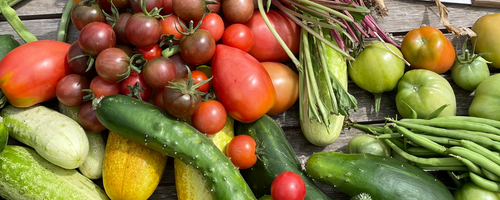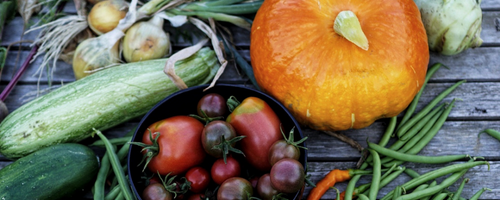Buying seeds: What to look out for when choosing
Buying seeds: What to look out for when choosing
The new seed catalogs are coming soon and with them the question of what to buy. In my last article, I discussed the calculation of seed requirements / quantities. Now the question is: Which varieties should I buy? Below is my personal opinion on the different types of seed. They represent a loose compilation of different forms of seed according to origin / production / quality and sustainability. This is expressly not a statement on good or bad and is certainly not always scientifically correct.
F1 seeds : Advantages of seed-resistant seeds
F1: This seed is the result of crossing two varieties of the same species. This is intended to combine the positive characteristics of the two original plants. Unfortunately, these plants are not suitable for further seed production, as the offspring partially lose these characteristics again according to Mendel's laws (not seed-firm / pure-bred). F1 initially says nothing about the conditions under which the seed was produced (organic? genetically modified? patent-free?). I only try F1 if it is the only way to achieve a certain characteristic that is important to me (e.g. resistance): In contrast to F1, the characteristics of the offspring of these plants correspond to those of the "parents" (if there is no cross-pollination). They can therefore be bred by the gardener. I prefer seed-resistant varieties, as the characteristics of the harvest basically remain the same over the years. However, seedfast alone says nothing about the production method.
Seeds of old varieties
At the beginning of this year, this was written about in detail here in the magazine, especially that there is no precise definition of "old". For vegetables, in my opinion, these are varieties that were already widespread 60 or more years ago or were regional specialties. These varieties are often kept "alive" in a conservation breeding program. Personally, I do not attach any great importance to "old varieties". The conditions in terms of climate and personal requirements have changed. Do the "old varieties" still produce the best yields? How can a new variety with the best characteristics become an "old variety" if nobody buys it?
Variety types
Type: There are different "variety types" for a number of species. These types have a "typical" characteristic that this "family" has in common. Here are a few examples, although I will not go into the characteristics in detail: - Savoy cabbage: "Puttjes. This savoy cabbage "family" does not close a solid head and has a hollow in the middle. - Onions: American or Rijnsburger type (different susceptibility to disease). - Carrots: Nantaise (root shape). If a type characteristic is referred to, you should find out what is meant by it and what advantages or disadvantages are attached to this family. What I am getting at with my contribution: before buying, always consider what is important to me, what I attach particular importance to and who I want to support. This also applies to the type of seed (whether Demeter, organic, etc.)
Specific variety characteristics

This is about the specific varietal characteristics, i.e. what distinguishes the kohlrabi in bag A from the kohlrabi in bag B. Below I try to describe the varietal characteristics of the species I grow (so peppers, chillies and others are missing). I don't go into particular detail about colors and shapes, at most as a general distinguishing feature.
- Tomatoes: a more detailed explanation is probably unnecessary, the selection of shapes and colors is well known.
- Cauliflower: In addition to cultivation duration, cultivation time, cold tolerance, it is above all the color and structure of the flower (fine, or Romanesco) that make the difference.
- Zucchini: As with tomatoes, the variety of zucchini varieties in shapes and colors is probably known to everyone.
- Carrots: In addition to the color distinction and the cultivation period
Early carrots: 80 - 90 days from sowing to harvesting
Medium-early carrots: 100 - 120 days from sowing to harvesting
Medium-late carrots: 120 - 140 days from sowing to harvesting
Late carrots and storage carrots: 140 - 190 days from sowing to harvesting.There are two types here. - Chantenay type: Slightly shorter, tapered - Nantaise type: Rather long, slender with a blunt tip
Parisian type: Small, round cucumbers: There are only two groups here
salad or snake cucumbers, also known as land cucumbers, weighing 300 to 400 grams, and the pickling gherkin, weighing 80-150g. significantly smaller and lighter - Potatoes: here the main characteristics are the cooking properties (firm, predominantly firm and floury) and the harvest time early medium late with intermediate stages. When selecting the potato variety, you should pay attention to the "small print". This often provides information about resistance or susceptibility and cultivation characteristics (sensitive to lack of water, etc.). Read the variety description carefully when making your selection.
- Onion: I won't go into the special features of the air onion here, the rest can be roughly differentiated according to size (vegetable onion) and color (white, red, yellow). The subspecies have already been described in Part 1, and information on storage life and harvest time is interesting.
- Kohlrabi: According to the colors white and blue as well as the very thick ones (Superschmelz/Gigant). In addition to the size (Superschmelz), it is interesting that these do not burst or become woody and can remain standing forever. With kohlrabi, you should look at the variety characteristics. These range from the time of cultivation to the cultivation period and storage life. You should consider what you want, when and where you can plant them, where space is available, etc. The garden planner is certainly helpful here.
- Lettuce: Lettuce is similar to kohlrabi, with a wide variety of colors, shapes and growing times almost all year round. In addition to personal preferences, I look at the sowing times and when it is too hot for sowing or growing (shooting). If you take this into account when choosing your seeds, you can harvest lettuce from late winter (greenhouse) to late autumn.
There are plenty of other cabbage varieties (Chinese, red, white, etc. cabbage), but I pay attention to the time of harvest. As we no longer need the huge cabbages, I have focused on the pointed varieties, which are smaller but usually also quicker, so that I can replant them a few times. As I have noticed that some people are already scratching their hooves and want to order seeds, I have simply written this article down quickly. I hope I have been able to give you a few ideas for choosing seeds. Garden catalogs are like travel brochures, you have to read between the lines to be informed, and when you have found a variety, compare this variety description with that of another supplier, then you (maybe) get a plant with the characteristics you wanted. Have fun choosing varieties on the now long evenings.
Schöpp op
